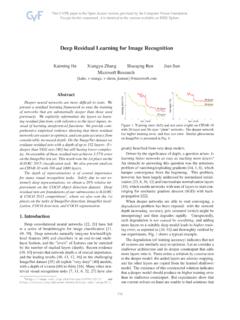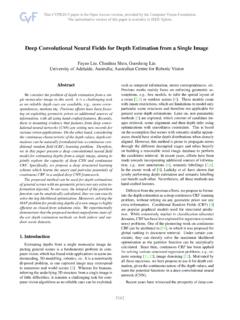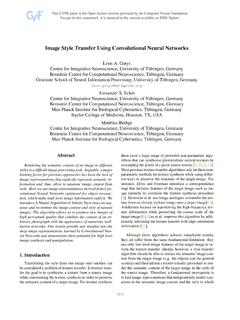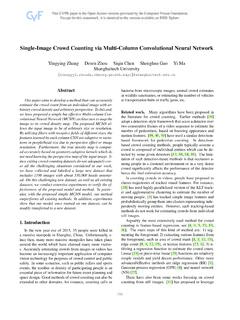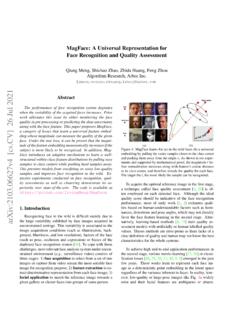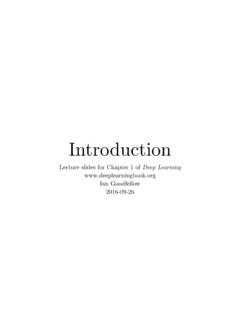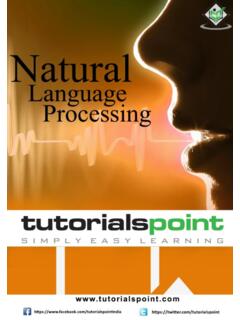Transcription of Unsupervised Visual Representation Learning by Context ...
1 Unsupervised Visual Representation Learning by Context PredictionCarl Doersch1,2 Abhinav Gupta1 Alexei A. Efros21 School of Computer Science2 Dept. of Electrical Engineering and Computer ScienceCarnegie Mellon UniversityUniversity of California, BerkeleyAbstractThis work explores the use of spatial Context as a sourceof free and plentiful supervisory signal for training a richvisual Representation . Given only a large, unlabeled imagecollection, we extract random pairs of patches from eachimage and train a convolutional neural net to predict the po-sition of the second patch relative to the first. We argue thatdoing well on this task requires the model to learn to recog-nize objects and their parts. We demonstrate that the fea-ture Representation learned using this within-image contextindeed captures Visual similarity across images.
2 For exam-ple, this Representation allows us to perform unsupervisedvisual discovery of objects like cats, people, and even birdsfrom the Pascal VOC 2011 detection dataset. Furthermore,we show that the learned ConvNet can be used in the R-CNN framework [19] and provides a significant boost overa randomly-initialized ConvNet, resulting in state-of-the-art performance among algorithms which use only Pascal-provided training set IntroductionRecently, new computer vision methods have leveragedlarge datasets of millions of labeled examples to learn rich, high -performance Visual representations [29]. Yet effortsto scale these methods to truly Internet-scale datasets ( ofbillions of images) are hampered by the sheerexpense of the human annotation required.
3 A natural wayto address this difficulty would be to employ unsupervisedlearning, which aims to use data without any , despite several decades of sustained effort, Unsupervised methods have not yet been shown to extractuseful information from large collections of full-sized, realimages. After all, without labels, it is not even clearwhatshould be represented. How can one write an objectivefunction to encourage a Representation to capture, for ex-ample, objects, if none of the objects are labeled?Interestingly, in the text domain,contexthas proven tobe a powerful source of automatic supervisory signal forlearning representations [3,38,9,37]. Given a large textcorpus, the idea is to train a model that maps each wordto a feature vector, such that it is easy to predict the words_ _ ?
4 ? Example: Question 1: Question 2: Figure 1. Our task for Learning patch representations involves ran-domly sampling a patch (blue) and then one of eight possibleneighbors (red). Can you guess the spatial configuration for thetwo pairs of patches? Note that the task is much easier once youhave recognized the object!Answer key: Q1: Bottom right Q2: Top centerin the Context ( , a few words before and/or after) giventhe vector. This converts an apparently Unsupervised prob-lem (finding a good similarity metric between words) intoa self-supervised one: Learning a function from a givenword to the words surrounding it. Here the Context predic-tion task is just a pretext to force the model to learn agood word embedding, which, in turn, has been shown tobe useful in a number of real tasks, such as semantic wordsimilarity [37].
5 Our paper aims to provide a similar self-supervised formulation for image data: a supervised task involving pre-dicting the Context for a patch. Our task is illustrated in Fig-ures1and2. We sample random pairs of patches in one ofeight spatial configurations, and present each pair to a ma-chine learner, providing no information about the patches original position within the image. The algorithm must thenguess the position of one patch relative to the other. Ourunderlying hypothesis is that doing well on this task re-quires understanding scenes and objects, good visualrepresentation for this task will need to extract objects andtheir parts in order to reason about their relative spatial lo-cation. Objects, after all, consist of multiple parts thatcan be detected independently of one another, and which11422occur in a specific spatial configuration (if there is no spe-cific configuration of the parts, then it is stuff [1]).
6 Wepresent a ConvNet-based approach to learn a Visual repre-sentation from this task. We demonstrate that the resultingvisual Representation is good for both object detection, pro-viding a significant boost on PASCAL VOC 2007 comparedto Learning from scratch, as well as for Unsupervised objectdiscovery / Visual data mining. This means, surprisingly,that our Representation generalizesacrossimages, despitebeing trained using an objective function that operates on asingle image at a time. That is, instance-level supervisionappears to improve performance on category-level Related WorkOne way to think of a good image Representation is asthe latent variables of an appropriate generative model. Anideal generative model of natural images would both gener-ate images according to their natural distribution, and beconcise in the sense that it would seek common causesfor different images and share information between , inferring the latent structure given an image is in-tractable for even relatively simple models.
7 To deal withthese computational issues, a number of works, such asthe wake-sleep algorithm [23], contrastive divergence [22],deep Boltzmann machines [45], and variational Bayesianmethods [28,43] use sampling to perform approximate in-ference. Generative models have shown promising per-formance on smaller datasets such as handwritten dig-its [23,22,45,28,43], but none have proven effective forhigh- resolution natural Representation Learning can also be formu-lated as Learning an embedding ( a feature vector foreach image) where images that are semantically similar areclose, while semantically different ones are far apart. Oneway to build such a Representation is to create a supervised pretext task such that an embedding which solves the taskwill also be useful for other real-world tasks.
8 For exam-ple, denoising autoencoders [53,4] use reconstruction fromnoisy data as a pretext task: the algorithm must connectimages to other images with similar objects to tell the dif-ference between noise and signal. Sparse autoencoders alsouse reconstruction as a pretext task, along with a sparsitypenalty [39], and such autoencoders may be stacked to forma deep Representation [32,31]. (however, only [31] was suc-cessfully applied to full-sized images, requiring a millionCPU hours to discover just three objects). We believe thatcurrent reconstruction-based algorithms struggle with low-level phenomena, like stochastic textures, making it hard toeven measure whether a model is generating pretext task is Context prediction. A strongtradition for this kind of task already exists in the text do-main, where skip-gram [37] models have been shown togenerate useful word representations.
9 The idea is to train a3 2 1 5 4 8 7 6 ); Y = 3 , X = ( Figure 2. The algorithm receives two patches in one of these eightpossible spatial arrangements, without any Context , and must thenclassify which configuration was ( a deep network) to predict, from a single word,thenpreceding andnsucceeding words. In principle, sim-ilar reasoning could be applied in the image domain, a kindof Visual fill in the blank task, but, again, one runs into theproblem of determining whether the predictions themselvesare correct [12], unless one cares about predicting only verylow-level features [14,30,50]. To address this, [36] predictsthe appearance of an image region by consensus voting ofthe transitive nearest neighbors of its surrounding previous work [12] explicitly formulates a statisticaltest to determine whether the data is better explained by aprediction or by a low-level null hypothesis key problem that these approaches must address isthat predicting pixels is much harder than predicting words,due to the huge variety of pixels that can arise from the samesemantic object.
10 In the text domain, one interesting idea isto switch from a pure prediction task to a discriminationtask [38,9]. In this case, the pretext task is to discriminatetrue snippets of text from the same snippets where a wordhas been replaced at random. A direct extension of this to2D might be to discriminate between real images vs. im-ages where one patch has been replaced by a random patchfrom elsewhere in the dataset. However, such a task wouldbe trivial, since discriminating low-level color statistics andlighting would be enough. To make the task harder andmore high -level, in this paper, we instead classify betweenmultiple possible configurations of patches sampled fromthe same image, which means they will share lighting andcolor statistics, as shown on line of work in Unsupervised Learning from im-ages aims to discover object categories using hand-craftedfeatures and various forms of clustering ( [48,44]learned a generative model over bags of Visual words).
